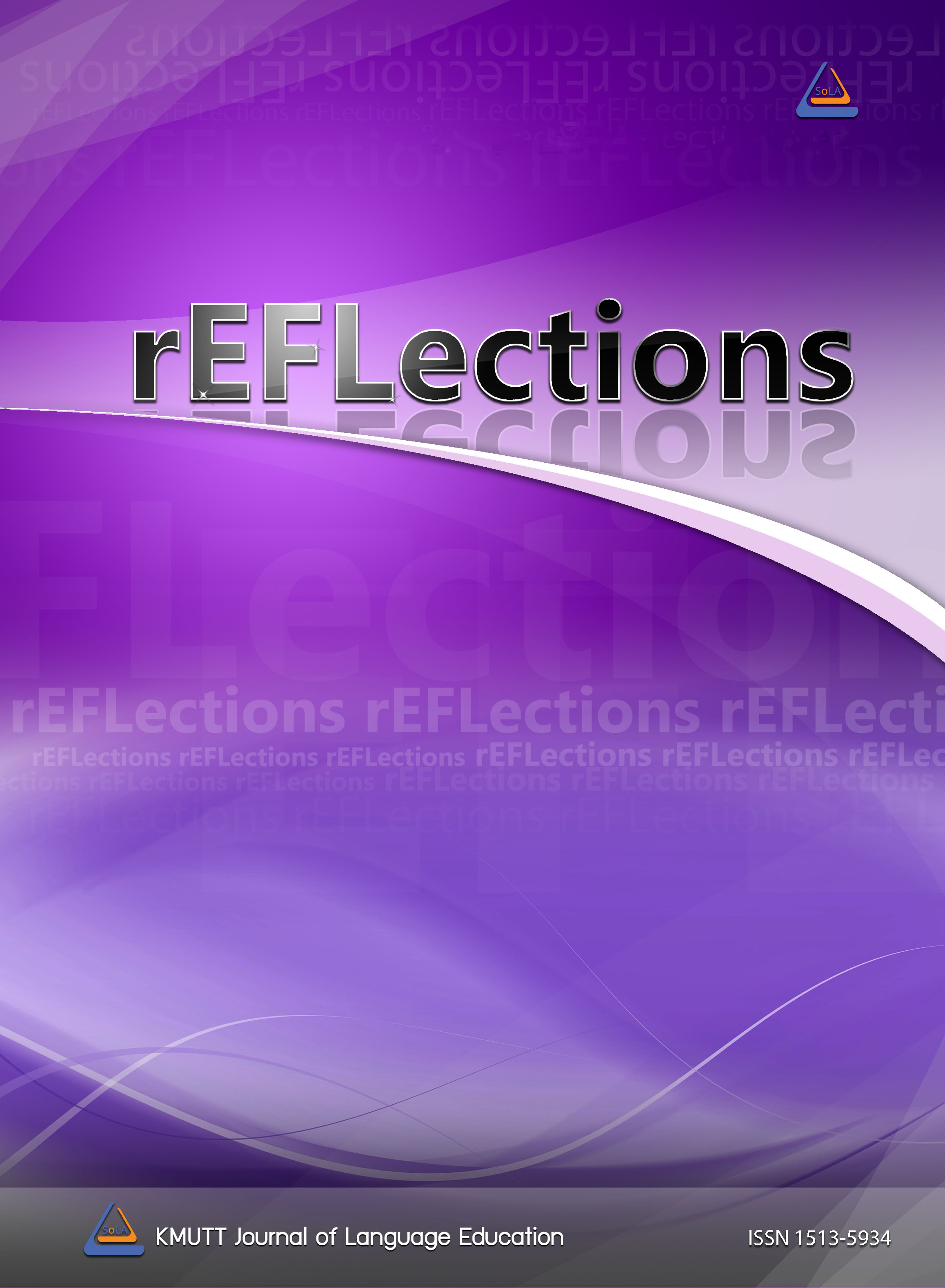Portfolio Assessment Among Thai EFL First-Year University Students: Perceptions and Progress
Main Article Content
Abstract
This research study investigated students’ perceptions toward the use of portfolios as well as documenting the progress of a portfolio assessment in a classroom-based setting of Thai EFL undergraduate students. The 25 first-year students who had enrolled in an English foundation course offered at a public university were the participants. These participants completed two types of essays, which comprised eight drafts in total for compiling the portfolios. Reflective journals, a perception questionnaire, a semi-structured interview, and a portfolio self-assessment form were utilized to collect data so that the perceptions toward the use of portfolios could be examined. The quantitative data from the perception questionnaire were analyzed by descriptive statistics (mean scores and standard deviation). The qualitative data from the reflective journals, semi-structured interview, and portfolio self-assessment form were analyzed by means of content analysis. Moreover, the progress of the eight drafts of two types of essays was analyzed by repeated measure ANOVA. It was found that the participants had positive perceptions toward the use of portfolio assessment, and they wrote significantly better essays. In sum, portfolio assessment can be an effective alternative choice in a classroom-based setting.
Article Details

This work is licensed under a Creative Commons Attribution-NonCommercial-NoDerivatives 4.0 International License.
References
Afrin, S. (2016). Writing problems of non-English major undergraduate students in Bangladesh: An observation. Open Journal of Social Sciences, 4, 104-115. https://doi.org/10.4236/jss.2016.43016
Al-Badwawi, H. S. Q. (2011). The perceptions and practices of first year students’ academic writing at the Colleges of Applied Science in Oman [Doctoral dissertation]. University of Leeds.
Boonyarattanasoontorn, P. (2017). An investigation of Thai students’ English language writing difficulties and their use of writing strategies. Journal of Advanced Research in Social Sciences and Humanities, 2(2), 111-118. https://doi.org/10.26500/JARSSH-02-2017-0205
Brown, J. D., & Hudson, T. (1998). The alternatives in language assessment. TESOL Quarterly, 32(4), 653-675. https://doi.org/10.2307/3587999
Camp, R., & Levine, D. D. (1991). Portfolios evolving: Background and variations in sixth-through twelfth-grade classrooms. In P. Belanoff & M. Dickson (Eds.), Portfolios: Process and product (pp. 194-205). Heinemann.
Chung, S. J. (2012). Portfolio assessment in ESL academic writing: Examining the effects of reflection in the writing process [Master’s thesis]. University of Illinois, Urbana, Illinois.
Davis, M. H., Ponnamperuma, G. G., & Ker, J. S. (2009). Student perceptions of a portfolio assessment process. Medical Education, 43, 89-98. https://doi.org/10.1111/j.1365-2923.2008.03250.x
DiCicco-Bloom, B., & Crabtree, B. F. (2006). The qualitative research interview. Medical Education, 40(4), 314-321.
Gibbs, G. (1988). Learning by doing: A guide to teaching and learning methods. Further Education Unit.
Hamp-Lyons, L., & Condon, W. (2000). Assessing the portfolio: Principles for practice, theory and research. Hampton Press, Inc.
Kalra, R., Sundrarajun, C., & Komintarachat, H. (2017). Using portfolio as an alternative assessment tool to enhance Thai EFL students’ writing skill. Arab World English Journal, 8(4). https://doi.org/10.24093/awej/vol8no4.20
Lam, R. (2018). Portfolio assessment for the teaching and learning of writing. Springer. https://doi.org/10.1007/978-981-13-1174-1
Nunes, A. (2004). Portfolios in EFL classroom: Disclosing an informed practice. ELT Journal, 58(4), 327-335.
Salma, U. (2015). Problems and practical needs of writing skill in EFL context: An analysis of Iranian students of Aligarh Muslim University. IOSR Journal of Humanities And Social Science (IOSR-JHSS), 20(11), 74-76. https://doi.org/10.9790/0837-201137476
Seensangworn, P., & Chaya, W. (2017). Writing problems and writing strategies of English major and non-English major students in a Thai university. Manutsat Paritat: Journal of Humanities, 39, 113-136.
Sermsook, K., Liamnimitr, J., & Pochakorn, R. (2017). An analysis of errors in written English sentences: A case study of Thai EFL students. English Language Teaching, 10(3), 101-110. https://doi.org/10.5539/elt.v10n3p101
Stevens, D. D., & Levi, A. J. (2005). Introduction to rubrics: An assessment tool to save grading time, convey effective feedback and promote student learning. Stylus Publishing.
Tedick, D. J., & Klee, C. A. (1998). Alternative assessment in the language classroom (ERIC Document Reproduction Service No. ED433720). Center for Applied Linguistics, Washington, D. C.
Turkkorur, A. (2005). Writing portfolio assessment and inter-rater reliability at Yıldız Technical University School of Foreign Languages Basic English Department [Master’s thesis]. Bilkent University.
Wanchid, R., & Charoensuk, V. (2015). The effects of paper-based portfolios and weblog-based electronic portfolios on limited English proficiency students in writing for service industry course. English Language Teaching, 8(9), 131-145.
Weigle, S. C. (2011). Assessing writing. Cambridge University Press.
Yancey, K. B. (1999). Looking back as we look forward: Historicizing writing assessment. College Composition and Communication, 50(3), 483-503. https://doi.org/10.2307/358862


